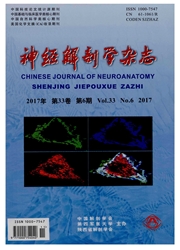

 中文摘要:
中文摘要:
目的:研究人脑皮层锥体神经元Na+电流的急性缺氧反应特征以及白藜芦醇(resveratrol,RES)对Na+电流缺氧反应的影响。方法:采用全细胞膜片钳记录法,在人脑皮层脑片上记录锥体神经元对TTX敏感的电压依赖性Na+电流,观察急性缺氧和白藜芦醇对Na+电流幅值和激活性质的影响。结果:(1)急性缺氧使人脑皮层脑片上的锥体神经元Na+电流呈现短暂的小幅增大后,出现长时程抑制(P〈0.05),并使Na+电流的I-V曲线左移(向超极化方向漂移)。(2)AMPA受体阻断剂NBQX阻断了缺氧引起的Na+电流短暂增大(P〈0.01),并加剧了Na+电流的缺氧后抑制(P〈0.01);GABA。受体阻断剂Bicuculline对Na+电流的缺氧性增大和缺氧后抑制无显著性影响(P〉0.05);二者对缺氧引起的Na+电流I—V曲线左移均无显著影响。(3)50μmol/L白藜芦醇阻断了Na+电流的缺氧性增大(P〈0.01),增强了Na+电流的缺氧后抑制(P〈0.05);100μmol/L白藜芦醇显著延迟了Na+电流的缺氧性反应,使Na+电流的缺氧性增大现象消失,并使Na+电流的缺氧后抑制现象衰减(P〈0.05)。50μmol/L和100μmol/L白藜芦醇均使Na+电流激活曲线右移,接近正常。结论:人脑皮层锥体神经元Na+电流对急性缺氧的反应主要表现为长时程抑制;AMPA受体活动可影响Na+通道对急性缺氧的反应。白藜芦醇对人脑皮层锥体神经元Na+电流缺氧反应的调节作用与剂量有关,小剂量可模拟NBQX的作用,而大剂量可降低Na+通道对低氧的敏感性。
 英文摘要:
英文摘要:
Objective : To study the properties and effects of resveratrol (RES) on Na+ currents of human cortical pyramidal neurons in response to acute hypoxia. Methods: Whole-cell patch-clamp technique was used to record the TTX-sensitive voltage-dependent Na+ currents of pyramidal neurons in human cortical slices, in order to investigate the effects of acute hypoxia and resveratrol on Na ~ current amplitude and activation properties. Results: ( 1 ) Acute hypoxia induced a brief and slightly increase in Na ~ current of human cortical pyramidal neurons followed by a long-lasting inhibition in amplitude (P 〈 0.05). I-V curve and the activation curve of Na+ currents were shifted leftwards (in the negative direction). (2) AMPA receptor antagonist NBQX blocked the hypoxic increase of Na+ currents (P 〈 0.01 ), and enhanced the posthypoxic inhibition of Na+ currents (P 〈 0.01 ) ; GABAA receptor antagonist Bicuculline had no significant effect on the hypoxic alterations of Na + currents ( P 〉 0.05 ). Both NBQX and bicuculline did not affect the shifting of I-V curve and activation curve. (3) 50 μmol/L resveratrol blocked the hypoxic increase of Na+ currents of human cortical neurons (P 〈 0.01 ), and aggravated the posthypoxic inhibition of Na+ currents (P 〈 0.05 ) ; 100 μmol/L resveratrol significantly delayed the responses of Na+ currents to acute hypoxia and completely blocked the hypoxic increase of Na+ currents and decreased the posthypoxic inhibition ( P 〈 0.05 ). The I-V curve and the activation curve of Na+ currents were shifted to right by either 50 μmol/L or 100 μmol/L, approximating normal level. Conclusion: Acute hypoxia mainly caused long-lasting inhibition in Na+ currents of human cortical pyramidal neurons. AMPA receptor may affect the responses of Na+ channel to acute hypoxia. The effects of resveratrol upon hypoxic responses of Na+ currents of human cortical neurons may be concentration-dependent. Low concentratio
 同期刊论文项目
同期刊论文项目
 同项目期刊论文
同项目期刊论文
 期刊信息
期刊信息
